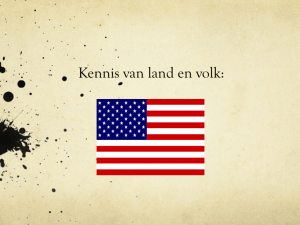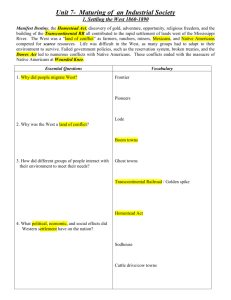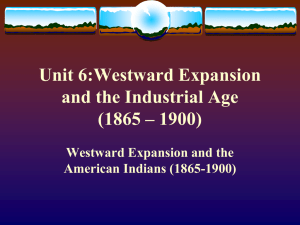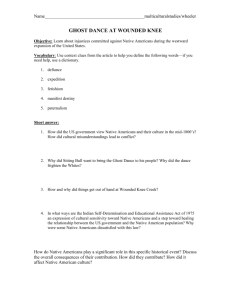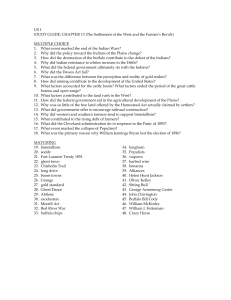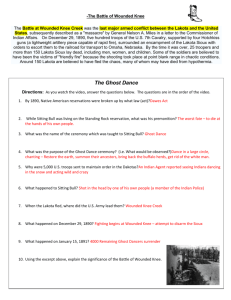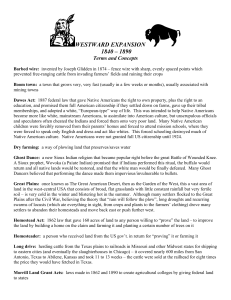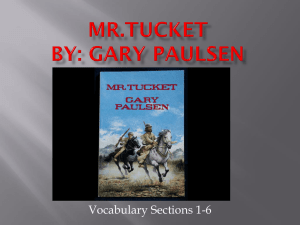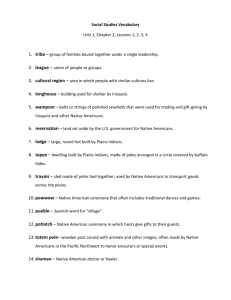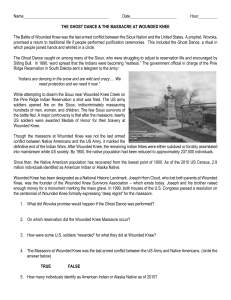Westward Expansion - Montgomery County Schools
advertisement
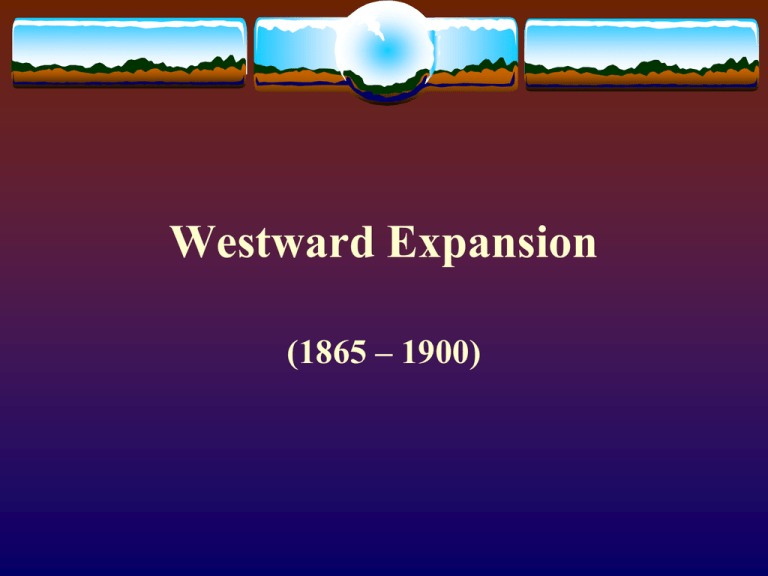
Westward Expansion (1865 – 1900) The Indian Wars 1830’s – President Andrew Jackson’s First Great Removal (The Trail of Tears) forced Indians in East to land west of the Mississippi. By the end of the Civil War, all surviving Native Americans were living on the Plains and in the West. By 1900, virtually all were forced onto reservations – poor tracts of federal lands – scattered throughout the West. Many would only go there after they were convinced they could not win the war against the U.S. Sitting Bull and the Fall of the Sioux 1864 - Sand Creek, CO Massacre (unarmed Cheyenne & Arapaho killed by Colorado militia Fetterman Massacre – Dec. 1866 – Dakota Territory – 1st Sioux War 1876- General Custer and Battle of Little Bighorn – 200+ soldiers killed Chief Joseph and the Nez Perce Pacific N.W. tribe of Wallowa Valley 1876-77 Joseph was forced to retreat on a 1100 mile march for Canada He was stopped Sept. 1877 only 40 miles from Canada at Big Hole Basin, MT Tribe was banished to reservation in Indian Territory in OK Massacre at Wounded Knee, SD After death of Sitting Bull, 200 Sioux killed at Massacre of Wounded Knee, SD (1890) The tragic end of the Ghost Dance War sealed the fate of the Indians. Native American Culture Destroyed 1860 – 13 million buffalo to 1000 est. in 1900! 1881 – Helen Hunt Jackson’s A Century of Dishonor spawned the “Indian Rights” movement Criminal Code of 1884 – Indians prohibited from practicing tribal religions (Ghost Dance – Wounded Knee (1890) Dawes Severalty Act (1887) gave plots of land to Native American families headed by a male, but Indians did not want to farm (assimilation). Exit Slip – The Indian Wars 1. 2. 3. 4. Poor tracts of land set aside for Native Americans are called _________. a. Reservations b. Bad Lands c. Plantations The last major victory for the Plains Indians against U.S. military forces was won at __________, Montana in June 1876. a. Butte b. Little Round Top c. Little Big Horn The goal of the Dawes Act of 1887 regarding Native Americans was __________. a. Assessment b. Accommodation c. Assimilation The last major conflict between Native Americans and U.S. forces occurred at _________, South Dakota in 1890. a. Lake Oahe b. Wounded Knee c. Sand Creek The Transcontinental Railroad (1869) Pacific Railway Act (1862) Sacramento to Omaha 2-5 miles of track per day Eur. Immigrants, Chinese, Af. Americans helped May 10, 1869 – Promontory Point, UT Opened the West! The Mining Industry CA Gold Rush of 1849 & Comstock , NV 1859 Miners panning for Gold 1870s – commercial mining = big business “Boomtowns” and “Ghost Towns” Vigilante Justice Cowboys and Ranching Texas Longhorns multiplied on the open range Indian removal and killing of buffalo opened land for cattle Long Drives – N TX Plains to railheads and cow towns (Abilene, KN, etc.) Frederic Remington “Stampede” - 1908 Cow Towns and Railheads The Homestead Act of 1862 1. 2. 3. 4. 5. Offered 160 acres of public land if: 21 years-old and head of family Any U.S. citizen or immigrant that filed $10.00 fee Build house/ 6 Mo./Yr. a resident Farm plot for 5 years The Exodusters 50,000-plus African Americans went West Led by Benjamin “Pap” Singleton Life was hard, but many adapted and escaped the racial hatred and violence of the South Farming on the Plains Not a farmers paradise due to the elements New farm machinery (John Deere’s steel plows, steam tractors, reapers, and combines) Dry weather crops = Dry farming (wheat, oats, etc.) Small farmers faced debt Was the West Really Wild? 1890 Census = Frontier Settled and Closed Joseph Glidden (1874) invented “barbed wire” Settlers and cowboys were only white males? Outlaw Myths? Who is this??? Exit Slip – Railroads, Miners, Ranchers, and Farmers 1. 2. 3. 4. T or F: Successful mining towns were often called ghost towns. T or F: Prior to the 1860s, longhorn cattle roamed wild on the Western plains. T or F: Homesteaders often built homes of sod because wood was scarce and too expensive to transport. T or F: Since fewer than 1,000 African-Americans migrated west after the Civil War it is safe to say that the settlers who did were predominantly white.
